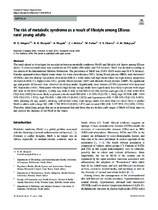| dc.description.abstract | The study aimed to investigate the association between metabolic syndrome (MetS) and lifestyle risk
factors among Ellisras
adults. A cross-sectional study was conducted on 624 adults (306 males and 318 females). MetS was
defined according to the criteria of the International Diabetes Federation. The prevalence of MetS
was 23.1% (8.6% males and 36.8 % females). Females appeared to have higher mean values for waist
circumference (WC), fasting blood glucose (FBG), total cholesterol (TCHOL) and low-density
lipoprotein cholesterol (LDL-C), while males had high mean values for high-density lipoprotein
cholesterol (HDL-C), triglycerides (TG), systolic blood pressure (SBP) and diastolic blood pressure
(DBP). No significant age and gender differences were observed for dietary intake. Significantly more
females (51.9%) presented with increased WC than males (4.6%). Participants who had a high dietary
energy intake were significantly less likely to present with larger WC (OR: 0.250 95% CI [0.161;
0.389]), low HDL-C (OR: 0.306 95% CI [0.220; 0.425]) and high LDL-C (OR: 0.583 95%
CI [0.418; 0.812]) but more likely to present with elevated FBG (OR: 1.01 95% CI [0.735; 1.386]),
high TCHOL (OR: 1.039
95% CI [0.575; 1.337]), high TG (OR: 1.186 95% CI [0.695; 2.023]) and hypertension (OR: 5.205 95%
CI [3.156; 8.585]).
After adjusting for age, gender, smoking, and alcohol status, high energy intake was more than two
times likely to predict MetS in adults with a large WC (OR: 2.766 95% CI [0.863; 3.477] and
elevated FBG (OR: 2.227 95% CI [1.051; 3.328]). Therefore, identifying groups that are at an
increased risk and those that are in their early stages of MetS will help improve
and prevent the increase of the MetS in the future. | en_US |

